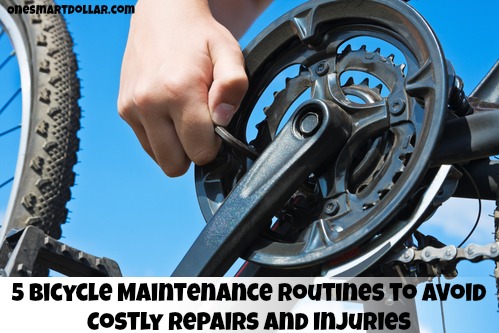
More people than ever are biking to save money on transportation. The number of bike trips in the U.S. more than doubled between 2001 and 2009, from 1.7 billion to 4 billion, according to the National Household Travel Survey. In bicycle friendly communities, bike commuting rates increased 105 percent from 2000 to 2013. In areas like Portland, as many as 7.2 percent of commuters now travel to work by bike.
If you depend on your bike to get to work, good vehicle maintenance habits are critical to avoid lost wages and the risk of injury. Here are some maintenance routines to help keep your bike in good working condition:
Preventive Routines
Preventing problems is the easiest form of maintenance. Store your bike inside to protect it from water and dirt. In addition, be aware that if you ride your bike in the rain or off-road, you need to do more work to maintain it. Cut down your maintenance needs by taking the bus instead of your bike on rainy days. If you don’t have an outdoor garage or shed to store your bike in, your best option is to get an indoor bike rack.
To-Do Items for Each Time You Ride
You should do certain safety checks every time you ride your bike. First, look at your wheels. If they feel soft, fill them up to the correct pressure. Make sure there is no embedded debris in your treads that could cause a flat. Spin your wheels to see if they run smoothly; if they wobble, you need to true your tires. If you have any quick-release parts, make sure they’re tight.
Inspect your bike chain. If it looks dirty or dry, clean it and add chain lube to reduce friction, ease gear shifting and keep your chain’s o-rings from cracking or falling off. Don’t use thin oils like WD-40 or Brunox Turbo-Spray that strip your chain’s oil and cause grinding. Wipe away excess oil after lubing.
Next, check your brakes to make sure they grab. Ensure your brake pads are in good shape and that they touch your rims instead of your tires.
If you’re using a mountain bike, check your suspension. Push down and release to make sure it is working properly.
Finally, make sure you have tools to make repairs in case of a flat tire. You should have a spare tube or a patch kit, tire levers and a pump.
Monthly Maintenance
Each month, clean your bike frame and inspect it for cracks or dents. Use a wrench to test the tightness of all connecting and moving parts, including bolts, pedals and crank arms. Check your wheels for loose spokes. Wipe and re-lube your chain and cassette cogs. Lube your brake system and gear cables, and check for rusting or fraying cables. For mountain bikes, check and lube your suspension.
Six-Month Inspections
Every six months, clean and wax your frame to protect its paint and finish, and check it for cracks and dents. Check your tires for cracks and tread wear, and make sure your spare tube and patch kit are in working condition. Check your wheel hubs, bottom bracket and headset. Check for chain, cassette cog and chainring wear. Clean your drivetrain. Check cables and housing for rust, corrosion, fraying and breaks. Replace any worn brake pads, handlebar tape and grips. Maintain your suspension for mountain bikes.
Annual Inspections
Finally, once a year, do a more in-depth inspection. Check all bearing systems. Inspect wheels for worn sidewalls or cracks where the spokes touch the rims or hubs. Check your hubs, bottom bracket and headset. Check your pedal bearings and straps and add grease. Inspect brake and gear cables, and replace worn brake pads, hoods and handlebar tape. Maintain suspension. Lube your frame and pump, and check attachments on baskets and other accessories.
